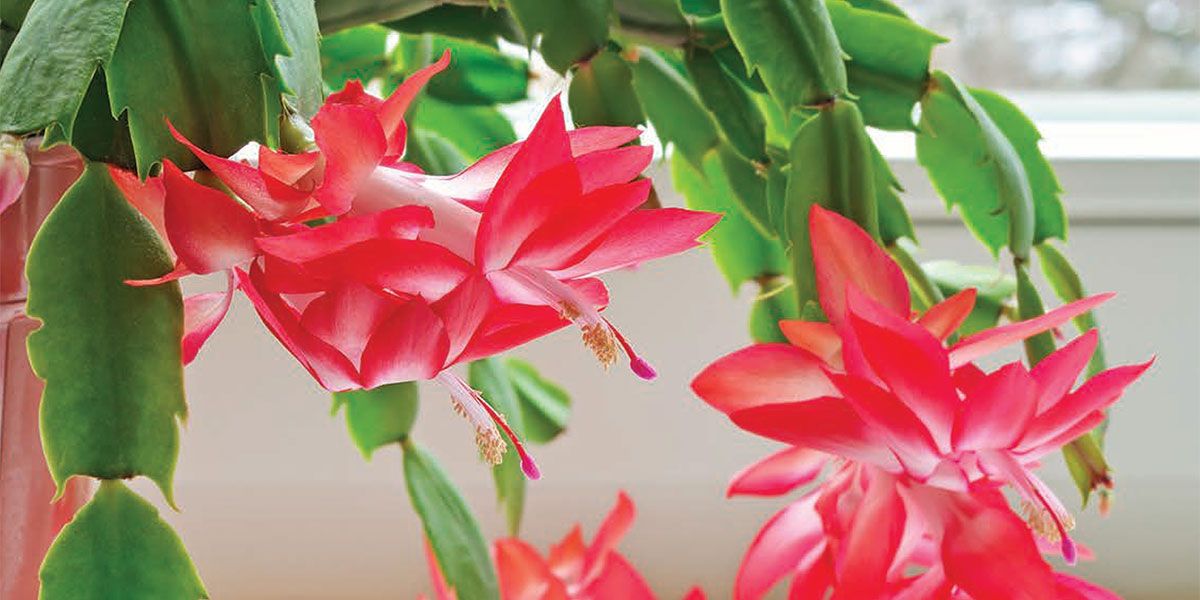CHRISTMAS IN BLOOM

A Cheery Cactus to Brighten the Holidays
While plant-lovers across the country associate Christmas cacti with wintertime, the Schlumbergera bridgesii actually hails from much milder climes, originating in the Southeast coastal mountains of Brazil. Unlike dry-climate cacti, this beautiful flowering succulent evolved to thrive in humid environments with lots of shade.
Perfectly suited for growing indoors, the Christmas cactus brightens interior décor with red, pink, purple, orange or creamy white flowers. Another bonus for dog lovers – they are not toxic to your cats and dogs. The longevity of these plants is impressive. With proper care, they can last decades, flowering year after year.
 Propagation techniques
Propagation techniques
There are several options for propagating. You can plant directly into soil, or you can root in water. Time your cuttings for when the cactus is dormant instead of when it is budding or blooming. Instead of cutting, pinch and gently twist off up to four segments, using the natural break between leaf segments. If planting directly into soil, make sure the soil is very moist and keep in a warmer area while roots grow. To grow roots in water, use a small glass container that allows you to keep the bottom inch submerged. You can also add small decorative stones to the jar to stabilize the cuttings. When roots appear, you can transfer to a pot with soil.
Potting and repotting
Planters should have good drainage to prevent roots from rotting and killing the plant. If repotting, aim for the new container to be three to six inches larger than its former home. Allow the plant to dry out a little before moving to the new container so the dirt stays intact. If the plant is rootbound, gently break up the roots. Add the new soil around the newly transplanted cactus and then water.
Caring for your cactus
A plant that prefers moderate climates, your cactus will thrive in temperatures between 60-70 degrees. Keep them away from heat sources, including warm air vents and radiators, hot windowsills and functioning fireplaces.
Christmas cacti are thermo-photoperiodic, which means they need six to eight weeks of either cool weather or darkness to help spur budding. Keep the plant in a colder area of the house or enclosed patio where temperatures are between 50-55 degrees. Give it 13 hours of darkness at lower temperatures between 55-70 degrees to start the budding process. Or you can provide the plant darkness for 15 hours at a time in temperatures above 70 degrees. Bear in mind that darkness at higher temperatures needs to be uninterrupted – so sequester in a closet or windowless room. Do not fertilize it, either. Think of it as a period of hibernation where you want the plant to be as dormant as possible.
Once you see buds, shift to an area that is bright and sunny, but without direct sunshine, which can dry it out.
 You will need to walk a line to keep your cactus at the right water level. Overwatering will cause the plant to wither, but it still needs to be kept hydrated. To mimic rainforest conditions, buy or upcycle a mister to spray your plant daily. Set the pot on a sealed tray with decorative pebbles and add water to the tray to provide additional humidity. Check the soil, and water only when the top is dry. When water runs through the bottom, it is saturated. Do not let it sit in runoff water — if the tray is too full of water, drain it until it is below the level of the pot.
You will need to walk a line to keep your cactus at the right water level. Overwatering will cause the plant to wither, but it still needs to be kept hydrated. To mimic rainforest conditions, buy or upcycle a mister to spray your plant daily. Set the pot on a sealed tray with decorative pebbles and add water to the tray to provide additional humidity. Check the soil, and water only when the top is dry. When water runs through the bottom, it is saturated. Do not let it sit in runoff water — if the tray is too full of water, drain it until it is below the level of the pot.
As with many plants, your Christmas cactus will be happiest in well-drained soil rich with compost. You can also add liquid fertilizer, following manufacturer’s instructions for timing and amount.
Blooms should appear about 12 weeks after the first buds form. You can even time your blooms by working backward from the date you hope to have flowers. Allow for two months of hibernation and three months for flowers to open and you can plan ahead for beautiful blooms that will last well over a month.

Did you know?
Allan Cunningham was the first botanist to collect and document the Christmas cactus during an expedition to Brazil in the early 1800s.
— Birds & Blooms
Get creative with cacti
With Christmas cacti in bloom, be sure to show them off. Use them as bold table centerpieces, hang plants from the ceiling to fill empty corners, place them on the ends of shelves for pops of color and greenery. You might also display several together in matching or complementary planters to create a colorful indoor garden.
Take care of your beautiful Christmas cactus this winter, and it will bring joy season after season! ✦
Christmas cacti, potting, propagating, repotting, Schlumbergera bridgesii, table centerpieces, thermo-photoperiodic







